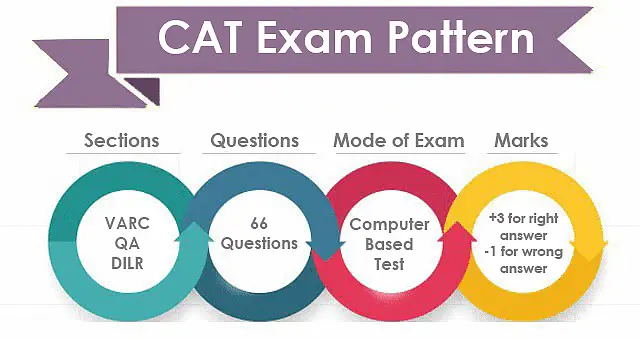CAT exam pattern with a focus on Quantitative Ability, Data Interpretation, and Logical Reasoning. Master various data types for success.
The Common Admission Test (CAT) is a pivotal exam for those aspiring to pursue an MBA or similar management programs in India. This standardized test is a crucial step in the admissions process for over 1,200 business schools, including the prestigious IIMs. The CAT exam pattern is designed to assess a candidate’s aptitude across multiple domains, making it an essential tool for evaluating potential business leaders.
The CAT Exam Pattern is crucial to understand as it shapes not only the academic evaluation but also tests time management, decision-making, and the ability to perform under pressure. Each year, the CAT exam attracts a diverse pool of candidates from various educational and professional backgrounds, emphasizing its role as a gateway to top-tier management education.
Understanding the CAT exam pattern is crucial for effective preparation. The exam’s structure, which includes sections on Verbal Ability and Reading Comprehension (VARC), Data Interpretation and Logical Reasoning (DILR), and Quantitative Ability (QA), demands a strategic approach. This article will provide a detailed overview of the CAT exam pattern, covering everything from the exam’s structure to preparation tips. Additionally, we will discuss the CAT exam fees, including the fee structure, payment options, and potential waivers. By the end of this article, you will have a comprehensive understanding of the CAT exam pattern and be well-prepared to tackle this test.

Read more: Is CAT Exam Tough : Difficulty Level & Pattern
CAT Exam Pattern
The CAT exam pattern plays a vital role in the MBA admissions process in India, serving as a key parameter of a candidate’s eligibility for top business schools. Understanding the CAT exam pattern is essential for those aiming to perform well. The CAT exam is structured into three sections: Verbal Ability and Reading Comprehension (VARC), Data Interpretation and Logical Reasoning (DILR), and Quantitative Ability (QA). Each section is designed to test specific skills critical for success in management education.
The CAT exam pattern emphasizes not only academic knowledge but also the ability to apply that knowledge in real-world scenarios. This makes the CAT exam a true test of a candidate’s potential to excel in the competitive world of business management.
Read More: CAT Syllabus 2024 (New Update): Download PDF With Weightage
Improve Your CAT 2025 Strategy: Tips for Success
Maximize Your CAT 2025 Preparation with Strategic Planning For those aiming to crack CAT 2025, a well-structured preparation strategy is crucial. Dive deep into proven methods and tips in our comprehensive guide on CAT 2025 Preparation Strategy.
Sections of the Exam

Verbal Ability and Reading Comprehension (VARC)
The VARC section of the CAT exam pattern assesses a candidate’s proficiency in English. It includes questions on reading comprehension, sentence correction, and verbal logic. Reading comprehension passages in the CAT exam are often complex and cover diverse topics.
Skills Assessed:
- Reading comprehension tests the ability to understand and interpret complex texts.
- Verbal ability focuses on grammar, vocabulary, and logical structuring.
The VARC section is crucial in the CAT exam as it evaluates skills essential for management professionals, such as clear communication and critical thinking.
Question Types:
Reading Comprehension (RC)
In the CAT exam pattern, the Reading Comprehension (RC) section is designed to test your ability to understand, interpret, and analyze various types of written passages. You will encounter passages on a range of topics, including literature, social and cultural issues, history, science, technology, and economics. The questions generally fall into several categories:
- Detail-Based Questions: In the CAT exam pattern, some questions require you to find specific information directly mentioned in the passage. For example, you might be asked to identify a particular date, fact, or character detail that is explicitly stated in the text.
- Inference-Based Questions: In the CAT exam pattern, these questions go beyond the surface level and ask you to infer meanings or conclusions that are not directly stated but can be logically deduced from the passage. For instance, you might need to understand the author’s implied opinion or the underlying significance of a statement.
- Summary Questions: In the CAT exam pattern, you will need to choose the best summary of the passage or identify the central theme. These questions assess your ability to distill the passage into a concise summary that captures the main points and overall message.
- Logical Questions: These questions test your understanding of the logical flow and structure of the passage. You might need to determine how different parts of the passage relate to each other or how certain statements support or contradict each other.
Verbal Ability (VA)
In the Verbal Ability (VA) section, the types of question pattern are designed to assess various aspects of your English language skills:
- Para Jumbles: You will be given a set of jumbled sentences and asked to rearrange them into a coherent paragraph. This tests your ability to understand the logical flow and connections between sentences.
- Sentence Completion: In these questions, sentences with one or more blanks are presented, and you need to choose the word or phrase that best completes the sentence. This evaluates your vocabulary and contextual understanding.
- Error Spotting: These questions require you to identify grammatical errors in a sentence or choose the grammatically correct sentence from a given set. It assesses your knowledge of English grammar and usage.
- Fill in the Blanks: You will be asked to complete sentences with appropriate words or phrases to ensure the sentence is meaningful and grammatically correct. This tests your understanding of sentence structure and vocabulary.
- Odd One Out: This involves identifying the sentence or phrase that does not fit with the others in terms of context or theme. It evaluates your ability to recognize contextual coherence.
- Critical Reasoning: These questions assess your ability to evaluate arguments, identify underlying assumptions, and draw logical conclusions based on the given information.
Master the CAT Exam Pattern
Mastering the CAT exam pattern is a key step toward achieving success in the exam. With three distinct sections—Verbal Ability and Reading Comprehension (VARC), Data Interpretation and Logical Reasoning (DILR), and Quantitative Ability (QA)—it is essential to approach each one strategically. Understanding how to allocate your time and resources across these sections can significantly impact your overall score. To explore more strategies and in-depth guidance, be sure to check out the iQuanta home page.
Data Interpretation and Logical Reasoning (DILR)
The DILR section of the CAT exam pattern is known for its challenging nature. This section tests a candidate’s ability to analyze data and solve logical puzzles. The DILR section includes questions on data interpretation and logical reasoning, which are vital for decision-making in business scenarios.
Skills Assessed:
- Data interpretation focuses on the ability to interpret and analyze data from various sources.
- Logical reasoning tests problem-solving skills and logical deduction.
Mastery of the DILR section is essential for success in the CAT exam, as it assesses critical thinking and analytical abilities.
Question Types:
Data Interpretation (DI)
In the Data Interpretation (DI) section, question pattern are designed to test your ability to analyze and interpret data presented in various formats:
- Tables: Questions involve interpreting complex tables with multiple rows and columns. You may need to extract data, perform calculations, and solve numerical problems based on the table’s content.
- Graphs: This includes various types of graphs such as bar graphs, line graphs, pie charts, and more. You might be asked to interpret trends, compare data points, or calculate percentages and other metrics from the graphical data.
- Caselets: Short passages containing embedded data require you to analyze textual and numerical information. These passages may include tables, charts, or data sets that you need to interpret to answer the questions.
- Venn Diagrams: Questions involve understanding relationships between different sets represented by Venn diagrams. You will need to analyze intersections, unions, and complements of sets to answer the questions.
- Data Sufficiency: In these questions, you must determine whether the provided data is sufficient to answer a specific question. It tests your ability to assess and utilize data effectively.
Logical Reasoning (LR)
In the Logical Reasoning (LR) section, question pattern evaluate your logical thinking and problem-solving skills:
- Arrangements: This includes linear and circular arrangements where you must organize people, objects, or events based on given constraints and relationships.
- Puzzles: You will solve various scenario-based puzzles, including scheduling problems and seating arrangements, requiring logical deduction and problem-solving skills.
- Syllogisms: These questions involve deductive reasoning, where you need to determine if certain conclusions follow logically from given premises.
- Blood Relations: Questions involve understanding family relationships based on given clues and constructing family trees.
- Data-Based Reasoning: Problems in this category require you to draw conclusions from provided data sets or information.
Quantitative Ability (QA)
The QA section of the CAT exam pattern tests a candidate’s mathematical skills. This section includes questions on arithmetic, algebra, geometry, and number systems. The QA section is crucial for candidates from non-engineering backgrounds, as it levels the playing field by testing fundamental mathematical skills.
Skills Assessed:
- Arithmetic, algebra, geometry, and number systems.
- Problem-solving and quantitative analysis.
Success in the QA section requires a strong foundation in mathematics and the ability to solve problems efficiently under time constraints.
Question Type:
In the Quantitative Ability (QA) section, the question pattern cover a broad range of mathematical topics:
- Arithmetic: Questions involve percentages, profit and loss, time and work, time-speed-distance, ratios and proportions, mixtures and allegations, simple and compound interest, and averages.
- Algebra: You will encounter questions on linear equations, quadratic equations, inequalities, functions, and progressions (arithmetic and geometric).
- Number System: Topics include divisibility rules, factors and multiples, properties of integers, and base systems.
- Geometry: Questions cover properties of triangles, circles, quadrilaterals, polygons, and coordinate geometry.
- Modern Math: This includes permutations and combinations, probability, set theory, and binomial theorem.
Each section is designed to test a specific skill set and requires a targeted approach to preparation. Understanding the types of questions in each section and practicing them regularly will help improve your overall performance.
Read More: DILR For CAT 2024 : Syllabus, Strategy, and Practice Sets!
Exam Duration and Structure

The CAT exam pattern is designed to be completed within 120 minutes (2 hours). Each section is allotted 40 minutes, with a strict time limit that prevents candidates from revisiting sections once the time for that section has elapsed. This structure requires candidates to manage their time effectively and focus on each section individually.
The CAT exam pattern includes both Multiple Choice Questions (MCQs) and Type-in-the-Answer (TITA) questions. The inclusion of TITA questions, which do not have negative marking, allows candidates to demonstrate their skills without the penalty associated with incorrect answers in MCQs.
Types of Questions
- Multiple Choice Questions (MCQs):
MCQs in the CAT exam pattern consist of a question followed by four or five answer choices. Candidates must select the correct option. The CAT exam pattern emphasizes accuracy, as incorrect answers carry a penalty of negative marking.
Strategy: When preparing for the CAT exam pattern, a key strategy is to focus on accuracy and avoid guesswork due to the negative marking policy. It is crucial to answer only those questions you are confident about.
- Type-in-the-Answer Questions (TITA):
TITA questions in the CAT exam pattern require candidates to type in their answers without any options provided. These questions are typically found in the QA and DILR sections. Since TITA questions do not have negative marking, candidates are encouraged to attempt all TITA questions.
Strategy: Prioritize accuracy but attempt all TITA questions as they carry no penalty for incorrect answers.
Preparation Tips
To excel in the CAT exam pattern, candidates must adopt a strategic approach tailored to each section. Here are some section-wise tips:
Verbal Ability (VA):
To enhance your Verbal Ability for the CAT exam pattern, focus on refining your grammar and sentence structure by practicing para jumbles, sentence corrections, and critical reasoning exercises. Regular engagement with a diverse range of reading materials—such as fiction, non-fiction, newspapers, and academic journals—will help broaden your vocabulary and improve comprehension. Summarization techniques, like condensing long passages into shorter versions while retaining essential information, can significantly strengthen your understanding of complex texts. Consistent practice and exposure to varied content are key to developing a nuanced grasp of language and improving overall verbal skills.
Reading Comprehension (RC):
Improving your Reading Comprehension for the CAT exam pattern involves not just reading widely but also developing strategies to enhance your speed and depth of understanding. Engage with different genres and formats to build a well-rounded reading habit. Practice summarizing passages to extract and articulate the main ideas clearly, and tackle inference-based questions to hone your analytical skills. Regularly expanding your vocabulary will aid in grasping more sophisticated content and understanding subtle nuances in texts. By continually challenging yourself with diverse and complex materials, you can significantly boost both your reading speed and comprehension abilities.

Logical Reasoning (LR):
To strengthen your Logical Reasoning skills for the CAT exam pattern, immerse yourself in solving a variety of puzzles and engaging in critical reasoning exercises that require pattern recognition and problem-solving. Focus on understanding and identifying underlying patterns, which is crucial for efficient problem-solving. Practice regularly under timed conditions to simulate exam scenarios and improve your speed and accuracy. Developing a systematic approach to solving problems, along with frequent practice, will enhance your ability to tackle logical reasoning questions effectively and efficiently.
Data Interpretation (DI):
Mastering Data Interpretation for the CAT exam pattern involves becoming proficient with different types of data presentations, such as tables, graphs, and caselets. Start by concentrating on accuracy to ensure that you can interpret and analyze data correctly. As you become more comfortable with various formats, shift your focus to increasing your speed. Consistent practice with previous years’ papers can help you develop effective strategies for interpreting data quickly and accurately. Familiarity with data formats and honing your ability to extract and analyze information will enhance your performance in this critical area.
Quantitative Ability (QA):
Building a solid foundation in Quantitative Ability for the CAT exam pattern requires a thorough understanding of fundamental concepts across arithmetic, algebra, geometry, and modern math. Regular practice in problem-solving, coupled with learning and applying shortcuts, can significantly enhance your speed and efficiency. Emphasize understanding core principles rather than relying solely on memorization of formulas. Frequent review of key formulas and consistent practice will help solidify your grasp of quantitative concepts and improve your problem-solving abilities, leading to better performance in exams.
CAT Exam Fees
The fee structure for the CAT exam is designed to accommodate candidates from various socio-economic backgrounds, ensuring broad accessibility. The exam fees are categorized based on the candidate’s background and are as follows:
- General and NC-OBC Candidates: ₹2,500
- SC/ST/PwD Candidates: ₹1,250
These fees are non-refundable, which means once paid, the amount cannot be returned except under specific circumstances such as technical errors or duplicate payments. The differentiation in fee structure reflects the IIMs’ commitment to inclusivity, recognizing that financial constraints should not prevent deserving candidates from appearing for the exam.
Additional Costs
Apart from the standard CAT exam fees, candidates should be aware of potential additional costs that could arise during the application process:
- Late Application Fees: If candidates miss the standard application deadlines, they may incur additional charges. The late application fees are generally higher than the regular fees and are intended to encourage timely submissions. These fees can add to the financial burden if not planned for in advance.
- Correction Charges: If candidates need to make corrections to their application forms after submission, they might incur extra costs. These charges are typically applied to address errors or updates required in the application details, such as personal information or preferences.
- Additional Documentation Costs: In some cases, candidates might need to submit additional documents to verify their eligibility for fee concessions or other special considerations. The cost of obtaining and submitting these documents can add to the overall expenses.
To avoid these additional costs, it is advisable to complete and submit the CAT application form well before the deadlines and ensure all details are accurate from the start.
Payment Methods
Candidates have several options for paying the CAT exam fees, each catering to different preferences and circumstances:
- Online Payment: The most common and convenient method for paying the CAT exam fees is online. Candidates can use various payment options including:
- Credit/Debit Cards: Most candidates opt to pay using credit or debit cards due to their convenience and immediate processing.
- Net Banking: This method allows candidates to pay directly from their bank accounts, often providing a secure and straightforward payment process.
- UPI (Unified Payments Interface): Increasingly popular for its ease of use, UPI allows for instant transactions directly from mobile devices.
The online payment process is generally secure, with encryption and other security measures in place to protect candidates’ financial information. It also offers the advantage of immediate confirmation of payment.
- Offline Payment: Although less common, offline payment methods are available for candidates who may not have access to online payment options. These include:
- Demand Drafts: Candidates can obtain a demand draft from a bank and submit it to the designated authority. This method is useful for those who prefer or require a paper-based transaction.
- Bank Challans: Some institutions allow payment through bank challans, which are forms that candidates can fill out and pay at designated banks. This method is less frequently used but remains an option for some candidates.
Fee Waivers and Concessions
To ensure that the CAT exam remains inclusive and accessible to all candidates, the IIMs offer various fee waivers and concessions. These are intended to support candidates from economically weaker sections and those belonging to specific categories:
- Eligibility for Fee Waivers: Candidates from economically weaker sections (EWS), SC/ST, and PwD (Persons with Disabilities) categories may be eligible for reduced or waived exam fees. To avail these waivers, candidates must provide valid documentation during the application process. This could include caste certificates, disability certificates, or income proofs, depending on the category.
- Documentation: Proper documentation is crucial to secure fee waivers or concessions. Candidates must ensure that all required documents are accurately submitted along with their application to avoid delays or rejections.
Read More: How to Prepare for CAT in 8 Months : Resources & Study Plan
CAT Exam Pattern: Refund Policies and Application Procedures
Refunds for the CAT exam fees are generally subject to strict policies. They are usually processed only under specific conditions:
- Conditions for Refunds: Refunds may be considered in cases where multiple payments have been made due to technical glitches or errors during the payment process. Additionally, refunds might be issued if candidates face significant issues in completing their application due to technical difficulties.
- Application Process for Refunds: To request a refund, candidates must submit a formal request through the official CAT exam portal or contact the CAT helpdesk. The request should include details such as the transaction ID, payment receipts, and a valid reason for the refund. Once the request is submitted, it will be verified by the exam authorities. Upon approval, the refund will be processed to the original payment method. The processing time for refunds can vary, so candidates should allow for adequate time for the refund to be completed.
Understanding the CAT exam pattern is just as crucial as knowing the fee structure, additional costs, payment methods, fee waivers, and refund policies for the CAT exam. A smooth and well-planned application process requires candidates to carefully review all associated costs and ensure timely payment to avoid unnecessary complications. Proper financial planning and awareness of the application procedures can help candidates navigate the process more efficiently, allowing them to focus on preparing for the exam rather than dealing with financial or procedural issues.
Conclusion
The CAT exam pattern is a comprehensive test designed to evaluate a candidate’s aptitude across various domains essential for management education. The exam is divided into three sections: Verbal Ability and Reading Comprehension (VARC), Data Interpretation and Logical Reasoning (DILR), and Quantitative Ability (QA). Each section of the CAT exam pattern tests specific skills that are crucial for success in the field of management. The CAT exam pattern not only assesses a candidate’s academic knowledge but also their ability to apply that knowledge under pressure. Understanding the CAT exam fees is equally important. The CAT exam fees vary based on the candidate’s category, with provisions for fee waivers and concessions for eligible candidates. Ensuring that the CAT exam fees are paid on time and understanding the refund policies will help candidates avoid any financial complications during the application process.
CAT Exam Pattern: Strategies, Time Management, and Financial Planning
To succeed in the CAT exam, it is essential to thoroughly understand the CAT exam pattern and tailor your preparation accordingly. Focus on each section’s unique demands and practice consistently with the right study materials. Time management is crucial during the exam, so develop strategies to maximize your efficiency in each section. Additionally, plan your finances by understanding the CAT exam fees structure and be aware of any additional costs that may arise. Ensure that you meet all deadlines and follow the correct procedures for payment of the CAT exam fees to avoid any last-minute hassles. With the right approach and thorough preparation, you can navigate the challenges of the CAT exam and achieve your goal of securing admission to a top business school.
People also ask
What is the pattern of the CAT exam?
The CAT exam pattern consists of three sections: Verbal Ability and Reading Comprehension (VARC), Data Interpretation and Logical Reasoning (DILR), and Quantitative Ability (QA).
How many marks are in the CAT exam?
The CAT exam pattern includes 100 questions, with each correct answer earning 3 marks, totaling 300 marks.
Is CAT a tough exam?
Yes, the CAT exam pattern is challenging, but with proper preparation, candidates can excel.
What are the 3 sections in the CAT exam?
The three sections in the CAT exam pattern are VARC, DILR, and QA.
What is the eligibility for the CAT exam?
Eligibility includes a bachelor’s degree with at least 50% marks (45% for SC/ST/PwD).
Is CAT a 2-hour exam?
Yes, the CAT exam pattern is designed to be completed in 2 hours.
Can CAT exam reduce fees?
The CAT exam fees are reduced for SC/ST/PwD candidates, with additional fee waivers available.

